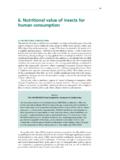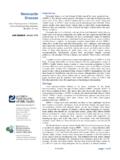Transcription of RURAL GROCERY STORES: IMPORTANCE AND …
1 RURAL GROCERY stores : IMPORTANCE AND challenges Jon M. Bailey Center for RURAL Affairs RURAL Research and Analysis Program October 2010 The local GROCERY store is an integral institution of RURAL communities and in RURAL life. Not only does the local GROCERY store provide the sustenance of life, it fills the roles of economic driver, community builder, employer and meeting place. Unfortunately, many RURAL communities across the nation are losing local GROCERY stores , and residents are forced to leave their communities to purchase food, often at great expense due to great distance. This brief examines trends regarding RURAL GROCERY stores , reasons why RURAL communities are losing GROCERY stores , and some of the personal and community implications when a community lacks a GROCERY store.
2 Finally, we examine some of the issues and challenges facing RURAL GROCERY stores . The Disappearing RURAL GROCERY Store RURAL GROCERY stores are slowly disappearing across the nation. Specific data on the decline can be seen in Midwestern and Great Plains states. In Iowa the number of GROCERY stores with employees dropped by almost half from 1995 to 2005, from about 1,400 stores in 1995 to slightly over 700 just 10 years later. Meanwhile, supercenter GROCERY stores (Wal-Mart and Target, for example) increased by 175 percent in the 10-year period. (O Brien) In RURAL Iowa, 43 percent of GROCERY stores in towns with populations less than 1,000 have closed.
3 (Procter) In Kansas, 82 GROCERY stores in communities of fewer than 2,500 people have closed since 2007, and nearly one in five RURAL GROCERY stores has gone out of business since 2006 (Kansas State; Procter). In total, 38 percent of the 213 groceries in Kansas towns of less than 2,500 closed between 2006 and 2009. (Impact Lab) As with many other traditional institutions in RURAL areas, the local GROCERY store is slowly being drained out of communities. The Reasons Why Many reasons conspire to leave a community without a GROCERY store. Declining populations mean that a number of RURAL communities are without an adequate customer base for a local store.
4 A certain population is needed to maintain a GROCERY store. In 2000, the average population needed to maintain a GROCERY store was 2,843. By 2005 the necessary population had risen to 3,252. (O Brien) While the minimum needed population is increasing, most RURAL communities and counties are decreasing in population. RURAL GROCERY stores , therefore, are fighting larger RURAL demographic trends. RURAL GROCERY stores are also fighting changes in larger purchasing patterns among Americans. Between 1990 and 2000, the incidence of residents in towns with populations under 2,500 out-commuting (going to work and presumably shopping in 1 other communities) increased by 72 percent.
5 The advent of corporate, chain GROCERY store facilities in nearby larger cities and the relative ease in driving due to advances in vehicles and highways often make shopping at larger GROCERY stores more attractive, further reducing the customer base and the economic margins for small, local stores . The lack of employment opportunities in many RURAL communities means RURAL residents have to work in larger communities, with shopping more convenient in places where people work. This combination of work and shopping patterns among so many RURAL people is also shown in consumer preferences of how people choose their GROCERY store.
6 A 2007 Nielsen Company study found that 60 percent of consumers stated that a GROCERY store that provides good value for the money was the most important factor in deciding where to GROCERY shop. Only 23 percent of consumers cite proximity to home as the most important factor. (Nielsen) Aging ownership and a lack of transfer opportunities may leave communities without a local store when owners retire or decide to leave the business. A lack of available small business capital in RURAL communities may also prevent younger or new entrepreneurs from beginning a GROCERY business.
7 All of these demographic and economic issues exist in many RURAL communities of the nation (and most RURAL communities of the Midwest and Great Plains), leaving a large section of the nation and a large portion of RURAL America to struggle with questions of how to provide food to a community in ways that benefit the local community. Implications for the Community For most RURAL communities facing the loss of a local GROCERY store, failure is not an option. Allowing a local store to close and remain closed until the community or the economy rebounds does nothing but place the community on a path for further depopulation and economic decline.
8 New residents and young families are unlikely to want to live in a community without a place to purchase food, and purchase patterns get set as people start and become accustomed to purchasing food in another community. The lack of resources and reliable transportation for many RURAL residents also raises the specter of hunger and unhealthy eating in communities without a local GROCERY store. The loss of local GROCERY stores and the continued consolidation of food retailers also affect RURAL populations differently. Of particular concern is the RURAL elderly. As their mobility and social support system diminish with the out-migration of younger family members they become more dependent upon non-local food sources to which they have to drive or find transportation.
9 (Morton 2004) An Iowa study of RURAL residents found significant long-term implications of the disappearing local GROCERY store. RURAL residents over 70 years of age are more dependent on the local GROCERY store and depend upon others more for transportation for GROCERY shopping. (Morton 2004) As GROCERY shopping and transportation options become less available in RURAL 2 communities the RURAL elderly are the ones who will be most affected. All residents in many RURAL areas of the nation no matter their age or income are affected by the growing phenomena of RURAL food deserts the lack of outlets to purchase food despite the public and private resources to do so.
10 The lack of access to GROCERY stores in many RURAL areas is striking. The most recent data available from USDA shows that 803 counties in the United States are classified as low access areas, meaning half or more of the population of the county lives 10 or more miles from a full-service GROCERY store. (Morton 2007) The Great Plains region has the largest concentration of such counties (while also hav-ing the largest concentration of high out-migration counties). USDA has classified 418 counties as food deserts all the residents of a county are 10 or more miles away from a full-service GROCERY store and 98 percent of those counties are RURAL .








